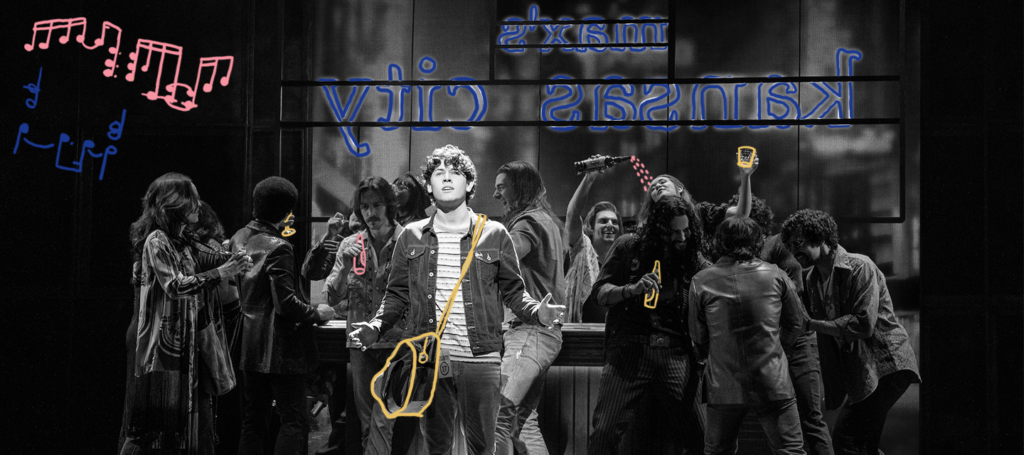


‘Almost Famous’ Takes Us on a Joyous Trip Down Memory Lane
I was in my early teens when I first watched Cameron Crowe’s Almost Famous and all I wanted to be in life after that was a groupie. As life played out, and considering I’m musically ungifted, it made much more sense to pursue the other career option in the film — a critic. Twenty-two years after the film’s release, and three years after its world premiere at San Diego’s Old Globe, the musical version of Almost Famous is making its Broadway debut.
The year, as the characters remind you constantly, is 1973. People in America are ruing the death of rock ’n’ roll, freelance music critics are being lowballed, and kids are doing drugs. But, people’s auras are still purple, and as the protagonist and music-obsessed journalist, William Miller’s (Casey Likes in his Broadway debut) mother, Elaine (Anika Larsen) says, “there’s, yet, hope for all of us.”
Almost Famous is the coming-of-age story of 15 (or is it 16? Maybe 17?)-year-old William who goes on a cross-country road trip with Stillwater, a rock band he’s profiling for Rolling Stone. In the process, he finds himself and discovers love in playful groupie (though she denounces the term) Penny Lane (Solea Pfeiffer, also making her Broadway debut).
Likes’ William, shines as the initially awkward but ultimately heroic protagonist, and as hard as it is to match up to the ethereal Kate Hudson, Pfeiffer sings and looks like a dream — radiant in a jeweled red velvet coat and impeccable in her singing of Tom Kitt’s music and lyrics. “She looks like a mix of Kate Hudson and Shakira,” I heard an audience member say on my way out, and I see it. Both in the way Pfeiffer carries herself and in her voice.
As the musical reimagines a cult movie for the stage, it is able to condense the plot’s long-winded road trip (on a bus called Doris) within the Bernard B. Jacobs Theatre stage, without being limited by it. The credit goes to Derek McLane, whose scenic and video design evokes the feeling of expanse that often gets lost in a screen-to-stage translation. Natasha Katz’s light design complements it perfectly.
The iconic scene inside the tour bus with the Stillwater crew, including Penny and William, singing Elton John’s “Tiny Dancer,” at once uses the power of music and film to mitigate a moment of high stress, creating a moment of lightness, laughter, and belief that all will be well in the world. In a feat of excellent adaptation, the Broadway production retains the scene’s joy and love, as the actors sit in rows, behind one another in a pretend bus, and sing out in delight.
Almost Famous nudges nostalgia at different levels; it looks back at the 1970s, and also inspires memories in the older millennial crowd who grew up with the film. The Broadway production, remarkably enough, achieves this while reinventing itself to fit the times. Considering Cameron Crowe wrote and directed the film more than two decades ago, Almost Famous stands the test of time. The Broadway version diversifies the film’s mostly-white cast, tightens up the plot, and does away with a few jokes, including one which used a musician’s coming out as a punchline. The additions and reworkings are subtle enough to not stand out to those who have the film memorized.
As much as Almost Famous is the coming-of-age of a teenager, it’s also the coming-of-age of a critic. It remains an important commentary on the nature of cultural criticism, and I am glad that this remains unchanged in the musical amidst all the added bells and whistles. William (who is based on Crowe) starts off as a methodic rookie journalist whose perspective expands as he is mentored by Creem and Rolling Stone journalist Lester Bangs (played unforgettably by Philip Seymour Hoffman in the movie and by Rob Colletti in the musical) and by the legendary Benjamin Fong-Torres (played by Matthew C.Yee in the musical) of Rolling Stone, who takes a chance on a writer he has only read, without caring much for how old he is, or where he went to school.
While one may argue with the different perspectives on criticism the plot takes, it is imperative to note that the basic message of the musical is that criticism needs to constantly evolve, the power of yielding a pen has to be shared and passed around. In an era of diminishing “honest” culture criticism, where a small number of editors hold an excessive amount of power (and gatekeep it), this is a timely reminder and required learning.
Like a good old friend, Almost Famous takes you on a trip and brings you home safely. For two hours, I sat back, humming along, grateful I chose to share a profession with greats like Bangs, Fong-Torres, and Miller.
Keep Reading

‘Walking with Ghosts’ is Forgettable, When It Should Be Haunting
This I believe to be true: theatre offers a form of time travel through storytelling. The performer becomes a spirit guide who guides us all towards meetings with ghosts of the past – in order to see more clearly the here and now. I believe it’s with the same intention that Gabriel Byrne created his […]
Read More
A Blazing Romp Through America’s Dog-Eat-Dog Butchery
Suzan-Lori Parks’ Pulitzer Prize-winning love letter to hustlers returns to Broadway in a powerful production. Although Topdog/Underdog premiered off-Broadway in a pre-9/11 United States, under Kenny Leon’s direction, this revival makes it look as if it were tailor-made for the era of betrayal and dissension we live in today. The play, set in Giuliani-era New […]
Read More












